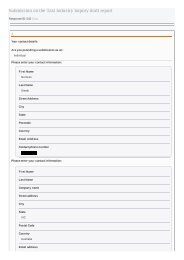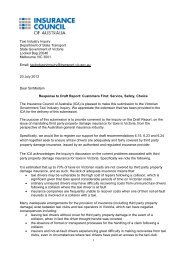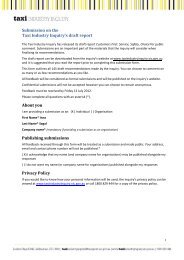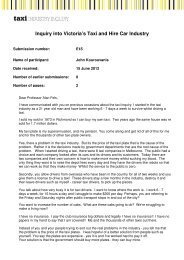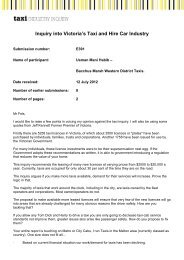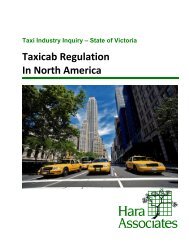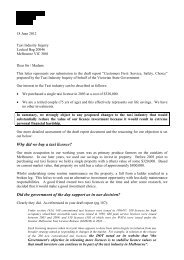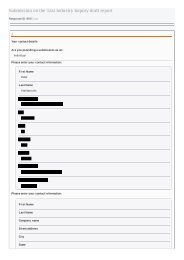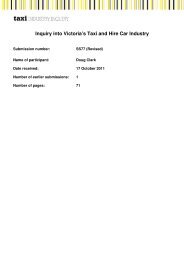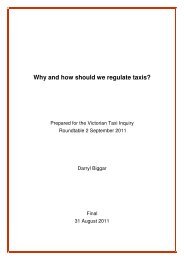Part D â Understanding and improving industry performance (PDF ...
Part D â Understanding and improving industry performance (PDF ...
Part D â Understanding and improving industry performance (PDF ...
You also want an ePaper? Increase the reach of your titles
YUMPU automatically turns print PDFs into web optimized ePapers that Google loves.
10.6. Regulations stipulating the<br />
functions of taxis, hire cars <strong>and</strong><br />
other forms of point-to-point<br />
transport<br />
Taxi <strong>and</strong> hire car licence conditions contain a number of<br />
provisions that are likely to have the effect of restricting<br />
competition between taxis <strong>and</strong> hire cars, <strong>and</strong> between<br />
these kinds of vehicles <strong>and</strong> other forms of public <strong>and</strong><br />
private transport.<br />
10.6.1. Competition between taxis<br />
<strong>and</strong> hire cars<br />
Features of regulation<br />
As noted in chapter 4, a number of regulatory features<br />
distinguish hire cars from taxis. In addition, a range<br />
of regulations that apply to taxis do not apply to hire<br />
cars, including common carrier obligations, availability<br />
requirements, livery <strong>and</strong> br<strong>and</strong>ing st<strong>and</strong>ards, m<strong>and</strong>atory<br />
affiliation with a network <strong>and</strong> dispatch <strong>and</strong> hiring<br />
preferences for disabled passengers.<br />
Moreover, vehicles cannot undertake particular sorts of<br />
hirings that would move their regulatory status from taxi<br />
or hire car services to bus services. For example, if a<br />
vehicle has capacity for more than 10 passengers, it is<br />
classified as a bus <strong>and</strong> is regulated accordingly (including<br />
in some instances being precluded from offering some<br />
services that have been contracted exclusively to a<br />
particular bus company). In addition, if taxis or hire cars<br />
run to a fixed route <strong>and</strong> passengers share the ride, this<br />
can be classified as a bus route <strong>and</strong> bus regulation<br />
<strong>and</strong> restrictions again apply. This makes it very difficult<br />
for taxis <strong>and</strong> hire cars to offer more flexible transport<br />
solutions in Melbourne’s outer suburbs <strong>and</strong> regional areas<br />
where bus services may not be economic. It may also<br />
preclude them from offering other innovative services.<br />
Themes raised in submissions<br />
Submissions that raised the issue of competition<br />
between taxis <strong>and</strong> hire cars generally did this within the<br />
context of hire car ‘touting’ at Melbourne Airport. The<br />
inquiry has received few submissions seeking increased<br />
competition between taxis <strong>and</strong> hire cars.<br />
One submission did argue that there are unjustifiable<br />
restrictions on hire cars that prevent more effective<br />
competition with taxis. The ESC argues that by<br />
preventing hire cars from having a meter in their vehicles,<br />
this may lessen their ability to compete with taxis as<br />
straight fare comparisons are not available:<br />
At present, hire cars are prohibited from having a<br />
fixed fare schedule – for example, a price per<br />
kilometre, or per passenger. They must agree a total<br />
fixed fee for the journey before it commences. This<br />
constraint to the pricing of hire car services is highly<br />
unusual, <strong>and</strong> appears to be directed to limiting their<br />
effectiveness as competitors to taxis by preventing<br />
customers from being able to make clear price<br />
comparisons. It is recommended that this constraint<br />
be removed, thereby enabling hire cars to pursue<br />
pricing strategies that most effectively enable them to<br />
compete with each other <strong>and</strong> with taxi <strong>and</strong> other<br />
passenger services. 108<br />
The VTD submission argues that the primary rationale for<br />
regulating the hire car sector is to:<br />
…protect consumers (e.g. probity of licence holders<br />
<strong>and</strong> vehicle quality) <strong>and</strong> to maintain an appropriate<br />
balance between the taxi <strong>and</strong> hire car markets. 109<br />
Further, the VTD argues that as taxis are highly regulated,<br />
similar services such as hire cars should also be<br />
regulated to ensure that “taxi services are not duplicated<br />
by services that fall outside the regulatory framework…<br />
it may be appropriate to consider a similar, but lighter,<br />
accreditation scheme for hire car operators”. 110<br />
The VTD also notes an odd feature of the requirement<br />
that vehicles, when new, have to be subject to the luxury<br />
car tax threshold. This feature is that the strong Australian<br />
dollar has made luxury vehicles cheaper, but has pushed<br />
the value of these vehicles below the threshold – meaning<br />
that a vehicle that previously qualified no longer qualifies.<br />
Analysis in previous reviews<br />
In 1999, KPMG reviewed the restrictions on competition<br />
that were perceived to exist through regulation. The<br />
KPMG analysis suggested that there were two main<br />
restrictions on hire car licences compared to taxi-cabs:<br />
• Age <strong>and</strong> other vehicle restrictions<br />
• The requirement that hire cars must be pre-booked.<br />
108 ESC (2008b), Op. Cit., p.15<br />
109 VTD, Op. Cit., p.40<br />
110 Ibid.<br />
216




